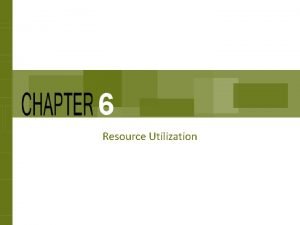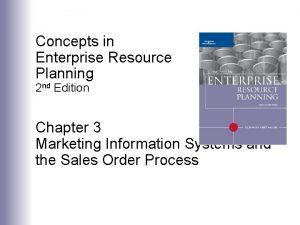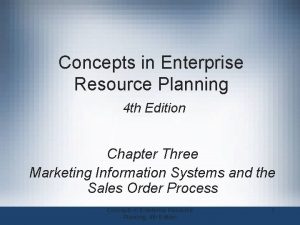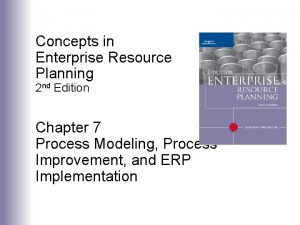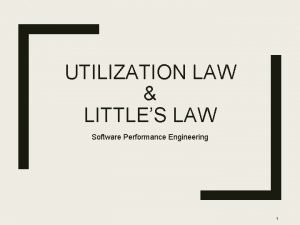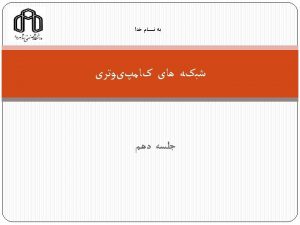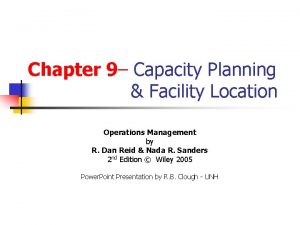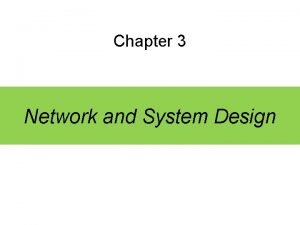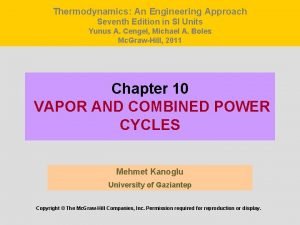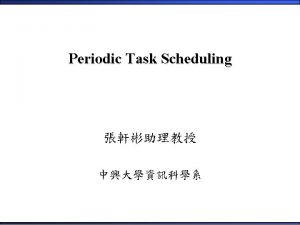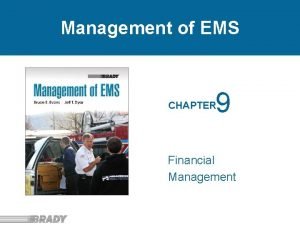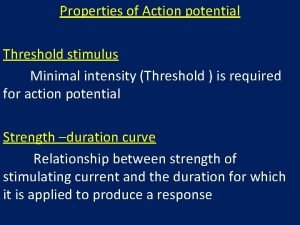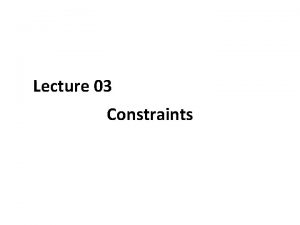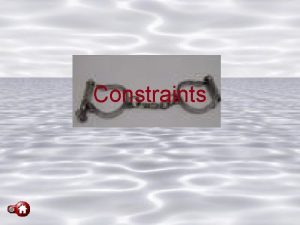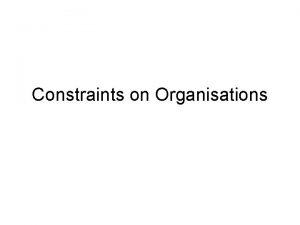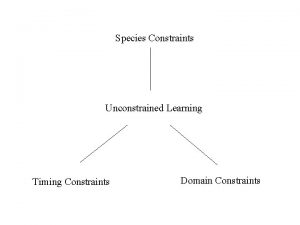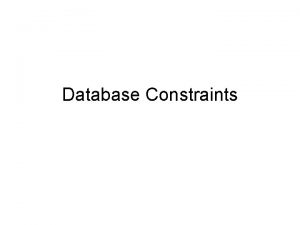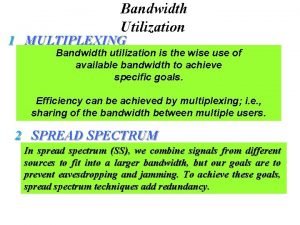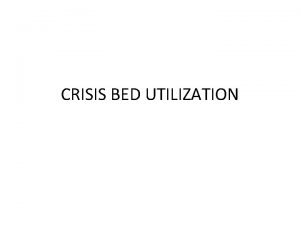6 Resource Utilization Chapter Concepts Taking resource constraints

































- Slides: 33

6 Resource Utilization

Chapter Concepts Taking resource constraints into account when developing a network diagram Determining the resource requirements plan for a project Leveling the use of resources within the required time frame of the project Determining the shortest project schedule with the limited resources available

Learning Outcomes Create a network diagram that takes resource constraints into account Prepare a resource requirements plan Explain resource leveling Discuss resource-limited scheduling

Project Management Knowledge Areas from PMBOK® Guide Project Human Resource Management

$3 Million Emerging Technology Fund Investment in Palmaz Scientific, Inc. Background A 17 -member panel reviews proposals for Texas Emerging Technology Fund Palmaz Scientific, Inc. was funded Projects that accelerate healing and improve patient well-being One man’s inspiration, but required a team of executives, physicians, scientists, and engineers Uses project management for research and development and taking products to market Why Funded Proven management team Innovative technology The project team works together in an innovation incubator Projects apply new techniques and materials to solve new problems Resources and creative teams have taken ideas to commercial applications

Allocating Resources in Multi-Project Programs: Lessons Learned from the Trenches Resource Allocation Problems Failure to determine true program capacity Project-tracking system that did not support program-level time tracking, only project-level tracking Only summary reports were made by project managers for resource pools Critical paths were calculated on individual projects only Solutions Determine supply and demand of project resources Use of an integrated enterpriseresource planning system to track interproject requirements for resources Examination of task requirements and tracking to avoid unnecessary resource conflicts Critical path analysis tool was implemented

Technical-Constrained Planning Serial relationship – performed in that sequence

Resource-Constrained Planning Available resources allow for concurrent tasks Limited resource availability constrains project

Resource Requirements Plan Illustrates the expected resource use by time period Indicate the amounts and types of resources needed to perform each activity

Example Painting Project: Resource Requirements

Resource Leveling Minimize resource requirement fluctuations Resources applied as uniformly as possible Attempt to keep project schedule within required time Delay start of noncritical activities Use positive slack Project management information systems assist If delay beyond slack and on critical path, project will be delayed beyond required completion time

How to level the painting project?


Resource Leveling (Smooting) ØResource leveling aims to minimize the period-by- period variations in resource loading by shifting tasks within their slack allowances. ØThe purpose is to create a smoother distribution of resource usage. ØResource leveling, referred to as resource smoothing, has two objectives: q. To determine the resource requirements so that they will be available at the right time, q. To allow each activity to be scheduled with the smoothest possible transition across usage levels.

Resource Leveling (Smooting) ØResource management is a multivariate, combinatorial problem, i. e. multiple solutions with many variables, the mathematically optimal solution may be difficult or infeasible. ØMore common approach to analyzing resource leveling problems is to apply some resource leveling heuristics.

Resource Leveling Heuristics ØPrioritizing resource allocation include applying resources to activities: qwith the smallest amount of slack qwith the smallest duration qthat start earliest qwith the most successor tasks qrequiring the most resources

Common Priority Rules As soon as possible As late as possible Shortest task first Most resources first Minimum slack first Most critical followers Most successors Arbitrary 8 -17

Resource Leveling Steps ØCreate a project activity network diagram ØCreate a table showing the resources required for each activity, durations, and the total float available ØDevelop a time-phased resource loading table ØIdentify any resource conflicts and begin to smooth the loading table using one or more heuristics

Resource Leveling Example Critical path: A-C-F-H-K

Resource Leveling Example Critical path: A-C-F-H-K

Resource Leveling Example Activity Duration Total Float Resource Hours Needed Per Week Total Resources Required A 5 0 6 30 B 4 1 2 8 C 5 0 4 20 D 6 3 3 18 E 6 1 3 18 F 6 0 2 12 G 4 3 4 16 H 7 0 3 21 I 5 3 4 20 J 3 5 2 6 K 5 0 5 25 Total 194

Resource Leveling Example

Resource Leveling Example ØOn day 10 the required resource hours is 10 ØIf project is budgetted for up to 10 resource units per day, then it is acceptable. ØC, D, and E are all scheduled on this day and have require 4, 3, and 3 hours respectively q. Which activity should be adjusted? q. C is on the critical path q. E has 1 day slack q. D has 3 days of slack (we can split the activity)

Resource Leveling Example

Resource-Limited Scheduling Develop shortest schedule Not exceed fixed available resources Extend the project completion time if necessary Give activities with the least slack first priority Delay lower priority activities

Example Painting Project: Limited Resources Limit of two painters

Example Painting Project: First Resource Allocation “First Floor Rooms” has a slack of 0 Other tasks are delayed

Example Painting Project: Second Resource Allocation Begin “Stairs & Hall” and “Bedrooms” Need to address limit for days 13 and 14

Example Painting Project: Third Resource Allocation Delay “Bathroom” to days 15 and 16 Project delayed by 4 days

Resource Requirements For Information Systems Development Five basic required resources § People, hardware, software, data, and network resources The more accurate the resource assessment, the more likely the project can be completed on time Most common problem – Overallocation § Resources assigned to multiple tasks at same time § Conflict results in lengthening the time

Project Management Information Systems Handle resource considerations within a project Create and maintain a list of resources Store availability, rate, and costs for resources Assign resources and calculate cost Assign calendar to record availability Resolve overallocations for best solution

Critical Success Factors Resources can constrain the project schedule because the quantities of various types of resources available to perform the project activities may be limited. It is necessary to estimate the types and quantities of resources required to perform each activity. If sufficient resources are not available when required, some activities may have to be delayed until a later time when resources become available to perform the activities. Resource leveling, or smoothing, is a method for developing a schedule that attempts to minimize the fluctuations in requirements for resources. It levels the resources so that they are applied as uniformly as possible without extending the project schedule beyond its required completion time. Resource-limited scheduling is a method for developing the shortest schedule when the quantity of resources is fixed. It will extend the project completion time if necessary.

Summary The consideration of resources adds another dimension to planning and scheduling; resources can constrain a project. Resources can include people, materials, equipment, tools, facilities, and other crucial elements to a project. A resource requirements plan illustrates the expected utilization of resources by time period during the time span of the project. Resource leveling, or smoothing, is a method for developing a schedule that attempts to minimize the fluctuations in requirements for resources when the project completion time is fixed. Resource-limited scheduling is a method for developing the shortest schedule when the quantity of available resources is fixed, and may extend the project completion time in order to keep within the resource limits.
 The resource requirements plan illustrates
The resource requirements plan illustrates Enterprise resourse planning
Enterprise resourse planning Concepts in enterprise resource planning
Concepts in enterprise resource planning Fitter snacker
Fitter snacker Objective of warehouse
Objective of warehouse Utilization law
Utilization law Efficiency of half wave rectifier
Efficiency of half wave rectifier Esa pus
Esa pus Cube utilization formula
Cube utilization formula Link utilization in stop and wait
Link utilization in stop and wait Citrate utilization test
Citrate utilization test Citrate results
Citrate results Tsi test: principle
Tsi test: principle Cascade utilization
Cascade utilization Drug utilization evaluation template
Drug utilization evaluation template Data utilization strategies
Data utilization strategies Asset utilization formula
Asset utilization formula Load distance method
Load distance method A common goal in designing process layouts is:
A common goal in designing process layouts is: Capacity utilization formula
Capacity utilization formula Litmus milk
Litmus milk Asset utilization analysis
Asset utilization analysis Basic unit of cpu utilization
Basic unit of cpu utilization Plant utilization factor
Plant utilization factor Throughput flow rate
Throughput flow rate Rate-monotonic scheduling
Rate-monotonic scheduling Unit hour utilization formula
Unit hour utilization formula Multilevel multiplexing
Multilevel multiplexing Bandwidth utilization multiplexing and spreading
Bandwidth utilization multiplexing and spreading Medication utilization evaluation
Medication utilization evaluation Oats amino acid profile
Oats amino acid profile Healthcare utilization project
Healthcare utilization project Research utilization process steps
Research utilization process steps Factors affecting chronaxie
Factors affecting chronaxie
